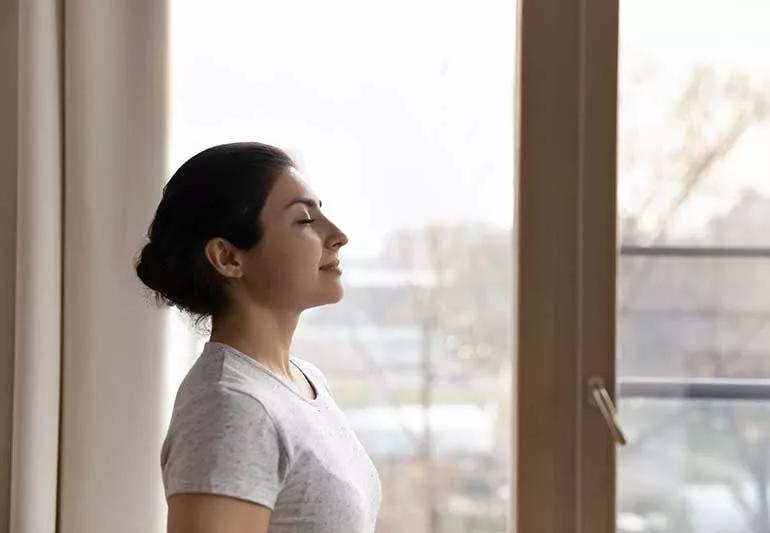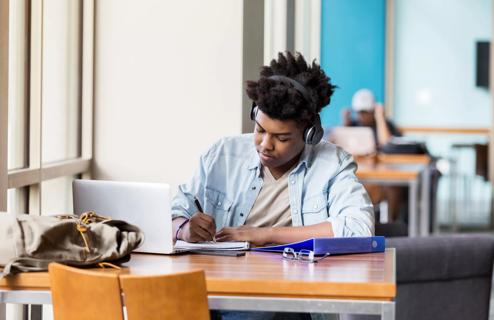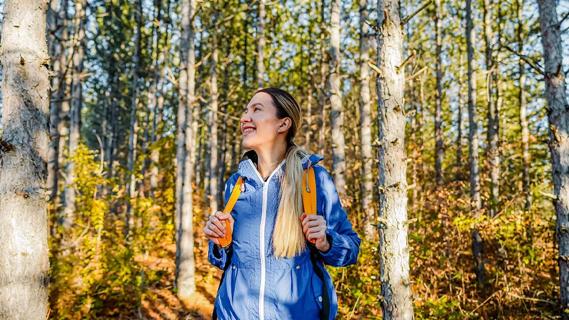5 easy steps to help with sleep, stress and more

We all want to relax. But relaxing is often the last thing on your to-do list — the prize after a long day at work or after the dishes are done or after the laundry is folded or after the kids are in bed… Or maybe you think of relaxation as something you only do on vacation.
Advertisement
Cleveland Clinic is a non-profit academic medical center. Advertising on our site helps support our mission. We do not endorse non-Cleveland Clinic products or services. Policy
But a daily relaxation practice might deserve a higher spot on your to-do list, according to sports medicine physician Matthew Kampert, DO. In particular, he recommends progressive muscle relaxation (PMR).
“Progressive relaxation is like a body scan that has a mental component and a physiological component,” Dr. Kampert says. “It involves using breathing and visualization to help you acknowledge and release the tension you hold in every area of your body.”
PMR isn’t quite the lay-on-your-couch-and-binge-Netflix kind of relaxing. But you can practice it anywhere, anytime, and see immediate and long-term mental and physical benefits.
Dr. Kampert explains more about how you can reap the benefits of a progressive muscle relaxation practice.
PMR involves alternately tensing (squeezing) and relaxing (releasing) your muscles. It’s “progressive” because you start at one end of your body — say your toes — and work your way up. Or you can start at your head and work down if you prefer.
You target one small, specific area at a time — like the top of your head, your stomach muscles or your toes.
Dr. Edmund Jacobson first introduced this technique in the 1920s, so it’s sometimes called Jacobson’s relaxation technique. The theory behind it is that physical relaxation encourages mental relaxation.
Advertisement
But physically relaxing your muscles this way does more than make you feel good. It helps your body shift from its sympathetic nervous system (or “fight-or-flight” mode) to the parasympathetic nervous system (also called “rest and digest”) mode.
Even small stressors — like losing your keys when you’re running late — can trigger your sympathetic nervous system and get your gears running at high speed. In simple terms, PMR allows your body to take its foot off the gas pedal and shift into neutral.
“The sympathetic nervous system increases your heart rate and causes muscles to contract,” Dr. Kampert explains. “With progressive muscle relaxation, you’re trying to calm down that sympathetic output and let your parasympathetic system take over. When that switch happens, you can see a change in your heart rate and blood pressure.”
The beauty of PMR is that it’s self-guided, and you can do it just about anywhere. While it’s most effective when done lying down, you can still get the benefits of doing PMR while at your desk, sitting in traffic or backstage before a big performance.
To begin, close your eyes. This helps shut out unnecessary stimuli and creates a better connection between your mind and muscles. Take a few deep “belly” breaths to slow down your sympathetic nervous system. Then follow these steps for each muscle group, beginning with your toes:
Work your way up your body, covering these areas:
For total body relaxation, Dr. Kampert says the process usually takes 10 to 20 minutes — possibly longer if you’re new to PMR. Areas of extreme tension may benefit from a second round.
Have just one tense area and need a quick fix? You can use the same steps and just target one troubled muscle group. Focused relaxation will help relieve that area. It won’t provide the same full-body benefits as progressive relaxation, but it’ll help if you’re short on time.
PMR can provide immediate results and yield long-term health benefits. Dr. Kampert shares these four major health benefits:
Anxiety symptoms like muscle tension and shortness of breath can be quite uncomfortable. But research shows that PMR can help control your body’s response to anxiety, especially when combined with cognitive behavioral therapy. And one study found PMR to be just as effective at reducing anxiety as acupuncture.
Advertisement
“The key is recognizing triggers and realizing when anxiety is starting,” Dr. Kampert notes. “With practice, you’ll be able to manage anxiety in the early stages.”
If you’ve ever exercised right before bedtime, you probably found it harder to fall asleep. Sometimes, your sympathetic nervous system gets activated late in the day from exercise, stress or too much stimulation (like screen time). PMR before bed could be a helpful tool for almost any busy person.
“When you go to bed, you want your heart rate and blood pressure down,” Dr. Kampert explains. “By calming everything down, you set the stage for sleep.” Once you’ve completed PMR, continue to focus on your breathing until you drift off to sleep.
Everyday stress can cause physical and mental tension — a recipe for headaches. But PMR reverses many of the stress responses that trigger headaches. According to the American Migraine Foundation, PMR is an accepted technique for controlling and preventing headaches. When used with biofeedback, the two tools together can reduce the frequency and severity of headaches by as much as 60%.
Using PMR regularly may also have long-term heart health benefits for people living with chronic stress. When your body releases stress hormones (adrenaline and cortisol), your heartbeat increases and your blood vessels constrict (tighten). This can raise your blood pressure. Even if you already have high blood pressure, research shows that PMR can improve your systolic blood pressure (the top blood pressure number).
Advertisement
Athletes often use PMR to manage stress or anxiety before a big event and perform their best.
Athletes commonly think that getting amped up before an event helps with performance or physical ability. But that’s actually inefficient, Dr. Kampert says. When adrenaline is pumping before the event, it increases your breathing, activates all your muscles and you burn through a lot of energy.
“But when you can breathe calmly and relax, you more efficiently distribute blood and activate the appropriate muscles,” he continues. Keep your mind and body relaxed before you perform to reserve energy for the muscles you’ll use during the competition.
Progressive muscle relaxation takes practice — especially to be able to use it to control stress or anxiety. Practicing it often will make you more aware of the tension you carry and how it feels to actively release it.
“Start by doing PMR somewhere you feel relaxed,” Dr. Kampert says. “Then try it in a situation or environment where you tend to feel anxious, and practice using it to calm yourself down.”
Using technology, like a smartwatch or heart rate monitor, can show you how PMR is affecting your body as you do it. When you can see how deep breathing and visualization directly impact your heart rate and blood pressure, you’ll be more likely to use those tools in stressful situations.
Advertisement
Overall, PMR is without any risks. But Dr. Kampert does recommend that you remember to get up slowly after practicing PMR to avoid any drop in blood pressure from standing too quickly. This is especially important for people taking blood pressure medication.
“In some instances, PMR can be as effective as medication when it comes to lowering blood pressure,” he adds. “If someone is on one or multiple blood pressure medications, those drugs may block the body’s ability to raise blood pressure. The combination can be concerning if PMR lowers your blood pressure even further.”
If you have high blood pressure or other health conditions, it’s a good idea to talk to your provider before beginning a new practice like PMR.
Learn more about our editorial process.
Advertisement

Breathing, exercise, mindfulness and more can help you unwind and step away from your stress

From breath meditation to yoga nidra, all types of meditation aim to help you feel calmer, more relaxed and present

Different types of yoga poses, meditation and breathwork may help you feel more emotionally balanced

Sensory deprivation therapy can help relieve stress, improve sleep and decrease physical pain

You don’t need to have years of experience to reap the rewards of meditation — with benefits for your whole body, you only need a couple minutes to get started

While walking, be mindful of your body, your mind, your place in the world and all five of your senses as you pave a path forward, one step at a time

Thunder, waterfalls and heavy rain — these low-frequency sounds might help cancel out disruptive noises and thoughts

Immersing yourself in nature can improve both your mental and physical health

The best parenting style balances enforcing rules and showing plenty of love

Tips include cutting back on sugar, focusing on exercise and managing stress

It can be harder to let go when you’ve invested time, energy and emotions — but it might be the healthier choice long term